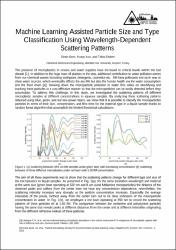| dc.contributor.author | Sinan Genc | |
| dc.contributor.author | Kutay Icoz | |
| dc.contributor.author | Talha Erdem | |
| dc.date.accessioned | 2021-07-27T06:59:57Z | |
| dc.date.available | 2021-07-27T06:59:57Z | |
| dc.date.issued | 2021 | en_US |
| dc.identifier.uri | https://hdl.handle.net/20.500.12573/875 | |
| dc.description.abstract | The presence of microplastics in oceans and water supplies have increased to critical levels within the last
decade [1]. In addition to the huge mass of plastics in the seas, additional contribution to water pollution comes
from our chemical wastes including toothpaste, detergents, cosmetics etc. All these pollutants end up in seas or
clean water sources, which eventually affects the sea life but also the human health via the water consumption
and the food chain [2]. Slowing down the microparticle pollution in water first relies on identifying and
tracking these particles in a cost-effective manner so that the microparticles can be easily detected before they
accumulate. To address this challenge, in this study, we investigated the scattering patterns of different
microplastic samples at different concentrations in aqueous samples. By analyzing these scattering patterns
obtained using blue, green, and red low-power lasers, we show that it is possible to classify the microparticles
particles in terms of their size, concentration, and first time for the material type in a liquid sample thanks to
random forest algorithm that accomplish the limited theoretical calculations.
Figure 1: (a) Scattering behavior of 8 um Me samples under green laser with increasing concentration (b) scattering
behavior of three different microplastics under red laser with 1.50 fM concentration.
The aim of all these experiments was to show that the scattering patterns change for different type and size of
the microplastics in liquid samples. As presented in Fig. 1(a), for the same excitation wavelength and material
at the same size (green laser operating at 520 nm and 8 um-sized Melamine microparticles) the distance of the
observed peaks and valleys from the center does not have any concentration dependence; nevertheless, the
scattering intensity increases very strongly as the particle concentration increases. Especially the average
intensities of the pixels, farthest away from the center turn out to be clear indicators of the microparticle
concentration in water. In Fig. 1(b), we employed a red laser operating at 650 nm to record the scattering
patterns of these particles all at 1.50 fM. The comparison between the melamine and polystyrene particles
having the same size reveals peaks at different distances from the center and at different intensities originating
from the different refractive indices of these particles. | en_US |
| dc.language.iso | eng | en_US |
| dc.publisher | Wroclaw University of Science and Technology (WUST) | en_US |
| dc.rights | info:eu-repo/semantics/openAccess | en_US |
| dc.subject | Machine Learning Assisted Particle Size and Type Classification Using Wavelength-Dependent Scattering Patterns | en_US |
| dc.title | Machine Learning Assisted Particle Size and Type Classification Using Wavelength-Dependent Scattering Patterns | en_US |
| dc.type | conferenceObject | en_US |
| dc.contributor.department | AGÜ, Mühendislik Fakültesi, Elektrik - Elektronik Mühendisliği Bölümü | en_US |
| dc.relation.journal | International Conference on Optics and Photonics 2021 (OPTO2021) | en_US |
| dc.relation.publicationcategory | Konferans Öğesi - Uluslararası - Kurum Öğretim Elemanı | en_US |


















